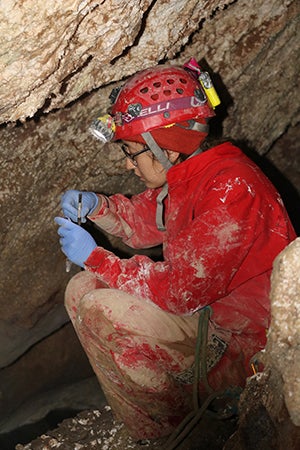Searching for a New Metabolism … for Bacteria
Oct. 23, 2020 | Jan Amend, professor of Earth sciences and biological sciences; divisional dean for the life sciences
 All life on Earth consumes ‘food’ to extract energy, and this extraction is coupled to the transfer of electrons inside (or on) the cell. My team, including graduate student Heidi Aronson (pictured here) and colleagues Doug LaRowe (USC Dornsife) and Jenn Macalady (Penn State), have used thermodynamic calculations to posit a new metabolism — combining the most oxidized and reduced forms of sulfur (specifically sulfate and sulfide) to yield intermediate elemental sulfur. For this reaction to yield energy, however, the environmental conditions have to be rather special. In addition to high levels of sulfate and sulfide, extremely acidic waters (pH less than 3) are necessary. The hypothesis paper was recently published in Environmental Microbiology. Now, Heidi is using waters, sediments, and slimes she collected from the Frasassi caves in Italy to try to grow unknown sulfur ‘comproportionators’ in the lab and to extract their DNA for further study. If she is successful, and preliminary data at pH 1 with only carbon dioxide as a carbon source are encouraging, we will try to isolate and characterize these novel organisms and will also search other favorable environments for similar organisms. Note that these other favorable environments are not necessarily limited to Earth.
All life on Earth consumes ‘food’ to extract energy, and this extraction is coupled to the transfer of electrons inside (or on) the cell. My team, including graduate student Heidi Aronson (pictured here) and colleagues Doug LaRowe (USC Dornsife) and Jenn Macalady (Penn State), have used thermodynamic calculations to posit a new metabolism — combining the most oxidized and reduced forms of sulfur (specifically sulfate and sulfide) to yield intermediate elemental sulfur. For this reaction to yield energy, however, the environmental conditions have to be rather special. In addition to high levels of sulfate and sulfide, extremely acidic waters (pH less than 3) are necessary. The hypothesis paper was recently published in Environmental Microbiology. Now, Heidi is using waters, sediments, and slimes she collected from the Frasassi caves in Italy to try to grow unknown sulfur ‘comproportionators’ in the lab and to extract their DNA for further study. If she is successful, and preliminary data at pH 1 with only carbon dioxide as a carbon source are encouraging, we will try to isolate and characterize these novel organisms and will also search other favorable environments for similar organisms. Note that these other favorable environments are not necessarily limited to Earth.